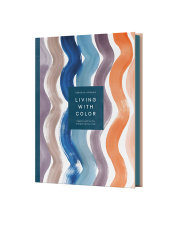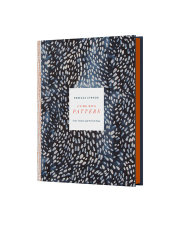IntroductionI’ve always looked to nature to make sense of things. In addition to my art, the landscapes I’ve lived in have shaped the way I think about my happiness and what I need to thrive. As a young girl, I remember sitting with my aunt Allison on the Cape Cod beach near where I grew up and telling her that one day I would have a room in my house with sand in it. I can still see the image that popped into my mind: It was a room like a screened porch with a floor covered in sand. There were low beach chairs, a rake for smoothing the sand, and rocks to play with.
This room in my future home looked out over the dunes and had a sweeping view so I could watch the changing scene: stormy gray days with crashing waves; peaceful mornings when the horizon is indistinguishable, with the water and sky blurring into one expanse; a colorful golden hour when everything is bathed in pink light.
In my imagination I lived right on the beach, but that wasn’t enough. I wanted the beach to surround me. I loved how I felt there. As a child I imagined that an adult could do anything, including create a house that was very tangibly like the beach. Looking back, I realize that even then I sensed just how much the landscape outside us intertwines with the landscape within us—in what I think of as our living landscape.
A beach room with a sandy floor doesn’t sound quite as magical to me now that I’m a grown-up with a young daughter and two cats. I remember why I wanted it, though. I was so drawn to the physical sensation of the sand. I loved the feeling of it—hard and packed in some areas and so soupy in others that I’d melt right into it. In the fall, I loved how it felt so cool when I sat down and settled in. I thought bringing sand into my home would bring me all the sensory delights of the beach. The soft, subtle colors. The salty air. These landscapes are essential to my creativity and my happiness. I learned to paint by painting the coast. Later on, when I was studying art at Rhode Island School of Design, abstract drawings finally clicked for me when my teacher, Alfred De Credico, taught me how to see them as landscapes. Applying the order of something I could see and understand— background, middle ground, foreground, like in a landscape painting or a still life—allowed me to imagine the marks and shapes coming together to capture a feeling or tell a story. Visualizing my thoughts, memories, emotions, stories, dreams, and sensations in this way, like the elements in a landscape, also helps me understand myself more clearly, especially when what I feel is complex, messy, or unpleasant. As an adult and a mother, when I’ve processed anxiety and deep sadness, I’ve closed my eyes and seen these emotions moving from the foreground to the background, changing as I breathed. This awareness during challenging times helps me embrace joy and beauty. I try to relish those times when the shapes, colors, and patterns I feel are at ease or musically moving in delight. Slowing down to see and imagine them grounds me. To be able to do that, I have to get out of my head. I can do it when I paint, when my hands take over. Sometimes I can do it in yoga. And sometimes the sun hitting a leaf a certain way on the sidewalk does it for me. The simple act of living in the moment and noticing the outer world quiets my thoughts and brings me back to myself. It helps me find harmony.
When I described this way of thinking about landscapes to my business coach, Holly Howard, she told me it reminded her of the Irish poet John O’Donohue. I listened to him on the
On Being podcast: “I think that connecting to the elemental can be a way of coming into rhythm with the universe,” he told host Krista Tippett. “And I do think that there is a way in which the outer presence, even through memory or imagination, can be brought inward as a sustaining thing.”
I had to pause, rewind, and listen again because what he said connected so much with me. That led me to read his work and that of others like the Irish poet David Whyte and Harvard psychology professor and mindfulness researcher Ellen Langer.
. . . Strangely when you pay attention to something other than yourself in silence, you actually become aware of your own body in a deeper way. It’s as if the world is actually looking back with the same intensity. You cleared a space. You’re fully in your body, but that body is paying attention to something other than itself and it’s created this live gravitational path between what you think is you and what you think is not you. —David Whyte
Mindfulness, for me, is the very simple process of actively noticing new things. When you actively notice new things, that puts you in the present, makes you sensitive to context. As you’re noticing new things, it’s engaging, and it turns out, after a lot of research, that we find that it’s literally, not just figuratively, enlivening. —Ellen Langer
If you can clear a space within yourself by focusing your attention outward, as Whyte says, you can see the colors, shapes, and textures of your inner landscape—your living landscape—more clearly and feel them more completely. For me, clearing that space means drawing. It means painting. It means sitting outside, feeling the wet grass and the cool air. It means spending quiet time alone. It means looking and surrounding myself with things that remind me to look. That’s where design comes in. You can design your surroundings to be in harmony with your living landscape if you’re intentional and considerate.
My Design Journey The importance of creating a harmonious home is personal to me, now more than ever. In 2021, after twelve years of living in New York, mostly in a onebedroom apartment in Brooklyn, my family of three moved into our first house in Charleston, South Carolina. It’s been such a big opportunity—and challenge. I’m an expert in color and patterns, but I’m a beginner when it comes to choosing and arranging furniture and the many other things that interior designers have such a special expertise in. I have friends who’ve offered helpful advice, but it’s mostly been trial and error.
It took me a few years to get to the point where I felt ready to have the house photographed. As you’ll see starting on page 238, it isn’t quite finished, and it’s usually messy (which you won’t see). That’s okay. It’s okay for yours to be messy, too. It’s all part of the process that requires, you know,
living in your house.
Putting together my house proved to me how helpful our favorite landscapes—the ones that nourish our souls—can be for making home design decisions. They’re where you find the colors, patterns, and shapes that make your home feel like you. This idea started to gel for me as I was writing my second book,
Living with Color. When it came out in 2019, I was often asked about how I create a color palette for a room. As I had conversations about the book, I found that I liked asking people about the landscapes that inspire them and then pulling colors from those to imagine a palette, which then could be used to design an environment. Now I’ve tested this theory out for myself, and I know it works.
The language of landscape can make design more accessible, too. Think of a place you love. Identify the colors there, and you can choose paint colors. Look closely at the textures, and you can decide what materials and patterns—for rugs, wallpaper, upholstery fabric—to bring into the room. That landscape can show you color and pattern combinations you wouldn’t have imagined on your own and elevate a room with contrasting finishes and textures borrowed from nature. I find these concepts to be richer and more reliable than using words like
modern, contemporary, transitional, bohemian, and
midcentury to try to define your design style, since those terms can mean such different things and don’t help most of us communicate how we want our home to look, feel, and function.
Decorating by landscape is more intuitive, looser, and more livable than designing a room around a theme.
It’s how a truly harmonious home comes together. That said, it still requires thought, practice, and curiosity, just like any other method. It may even take more time. Sometimes I feel as though I might never finish, as I always have more ideas. But I’m happy with the pieces I’ve put in place, and decorating has been easier to wrap my head around and more in rhythm with my life. I can’t put all my resources into my house—and that’s fine. There’s no need to do everything at once. A harmonious home is a living landscape, not an oil painting in a museum. It’s unfinished, always changing. It’s meant to evolve slowly.
Copyright © 2025 by Rebecca Atwood. All rights reserved. No part of this excerpt may be reproduced or reprinted without permission in writing from the publisher.


















